Article Figures & Data
- Table 1
Overview of the four existing approaches to define WMH change
Approach Regression Stable Progression Threshold 112 Decrease>0.25 mL Volumes from −0.25 mL up to 1 SD (of mean WMH volume change) Increase >1 SD (of mean WMH volume change) Threshold 23 Decrease>0.25 mL Volumes from −0.25 mL up to +0.25 mL Increase >0.25 mL Percentile4 Percentiles below the −10th percentile of no change Percentile of no volume change ±10 percentiles Percentiles above the +10th percentile of no change Quintile7 Data are divided in quintiles reflecting any net volume change. Quintile 1 (Q1): most volume decrease; quintile 5 (Q5): most volume increase WMH, white matter hyperintensity.
- Table 2
Participant distribution and WMH volume change (mL) after applying the four approaches to one dataset
Approach N (%) regression Regressing WMH change (mL) N (%) stable Stable WMH change (mL) N (%) progression Progressing WMH change (mL) Threshold 1 Mean volume (SD), (range) 59
(29.8)−1.36 (1.42)
(−7.98 to –0.26)110
(55.6)0.86 (0.89)
(−0.23, 2.81)29
(14.6)6.22 (3.07)
(2.88, 12.84)Threshold 2 Mean volume (SD), (range) 59
(29.8)−1.36 (1.42)
(−7.98 to –0.26)33
(16.7)−0.02 (0.14)
(−0.23, 0.22)106
(53.5)2.59 (2.82)
(0.25, 12.84)Percentile Mean volume (SD), (range) 56
(28.3)−1.42 (1.43)
(−7.98 to –0.33)42
(21.2)−0.01 (0.18)
(−0.28, 0.30)100
(50.5)2.73 (2.85)
(0.32, 12.84)Quintile Q1
(N=40)Q2
(N=40)Q3
(N=40)Q4
(N=39)Q5
(N=39)Mean (SD), (range) −1.79 (1.54)
(−7.98 to –0.68)−0.27 (0.20)
(−0.65, 0.03)0.35 (0.18)
(0.04, 0.70)1.43 (0.48)
(0.75, 2.33)5.31 (3.07)
(2.43, 12.84)Q, quintile; WMH, white matter hyperintensity.
Supplementary Materials
Supplementary data
Additional Files
Supplementary Data
This web only file has been produced by the BMJ Publishing Group from an electronic file supplied by the author(s) and has not been edited for content.






